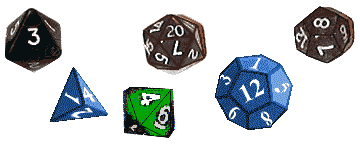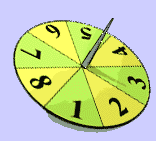|

Ideas that Lead to Probability
Abstract
The activity and two discussions that make up this lesson introduce ideas that
are the basis of probability theory. By using everyday experiences and intuitive
understanding, this lesson gives students a gradual introduction to probability.
Objectives
Upon completion of this lesson, students will:
- have been introduced to the concept of probability
- have worked with random number generators
- have learned what it means for a game to be fair
Activities
This lesson introduces students to the probability theory through the following activity:
Standards
The activities and discussions in this lesson address the following
Standard:
Key Terms
This lesson introduces students to the following terms through the included discussions:
Student Prerequisites
- Arithmetic: Students must be able to:
- use addition when working with dice
- Technological: Students must be able to:
- perform basic mouse manipulations such as point,
click and drag
- use a browser such as Netscape for experimenting with
the activities
Teacher Preparation
Students will need:
- access to a browser
- copies of the supplemental materials:
- The following objects or their pictures may be used in activities or to illustrate
the discussions.
- 1. Dice with various numbers of sides.

- 2. Spinners. 3. Bag of lotto pieces with numbers. 4. Lottery machine.



Lesson Outline
- The lesson can start by playing The Racing Game with One Die
using computers decreasing the number of steps to the finish line
to 1. As the game is used for illustration only, it can be played by
each student individually, by groups of students, or by one person who
broadcasts it for everybody else to see. Each group of students can come up with
their own way of randomly choosing which players move on which rolls.
- Lead a discussion about fair choice.
Students can use The Racing Game
with One Die
as an example
of a game that is either fair or not.
Next run The
Racing Game with One Die with multiple steps to discover how this changes
a players chances of winning.
- Students can start a discussion with each other
or with mentor(s) by trying to answer the following questions:
- What does it mean for a game to be fair?
- What are some examples of fair games that use dice? What are some examples of
unfair games?
- Is it always easy to tell if the game is fair or not? Is it possible to make
some experiments to find that out?
- Lead a discussion about random number
generators. Everybody has some expertise with random choices. This fact allows the
following questions to lead to spark a discussion:
- How can you randomly choose between any given numbers? Can you use some
devices to help you with that? What devices?
- How do you know if the choice is truly random? How do you know if it is fair?
Each group of students can come up with their own device for randomly choosing
numbers. Different groups can discuss each other's devices and answer the above
questions about them.
Alternate Outlines
This lesson can be rearranged in several ways.
Suggested Follow-Up
After these discussions and activities, the students will have
the beginnings of an understanding of probability, randomness and fair choice.
The next lesson, Unexpected Answers,
continues the initial exploration of probability and presents some unusual examples of
games that require close examination to determine if they are fair.

Please direct questions and comments about this project to Addison-Wesley
math@aw.com
© Copyright 1997-2001
The Shodor Education Foundation, Inc.
© Copyright 2001 Addison-Wesley. All rights reserved.
|




